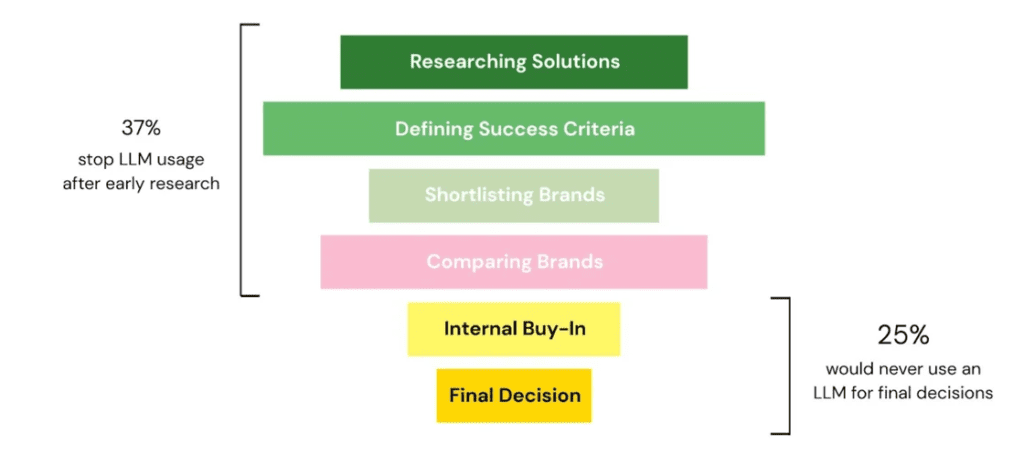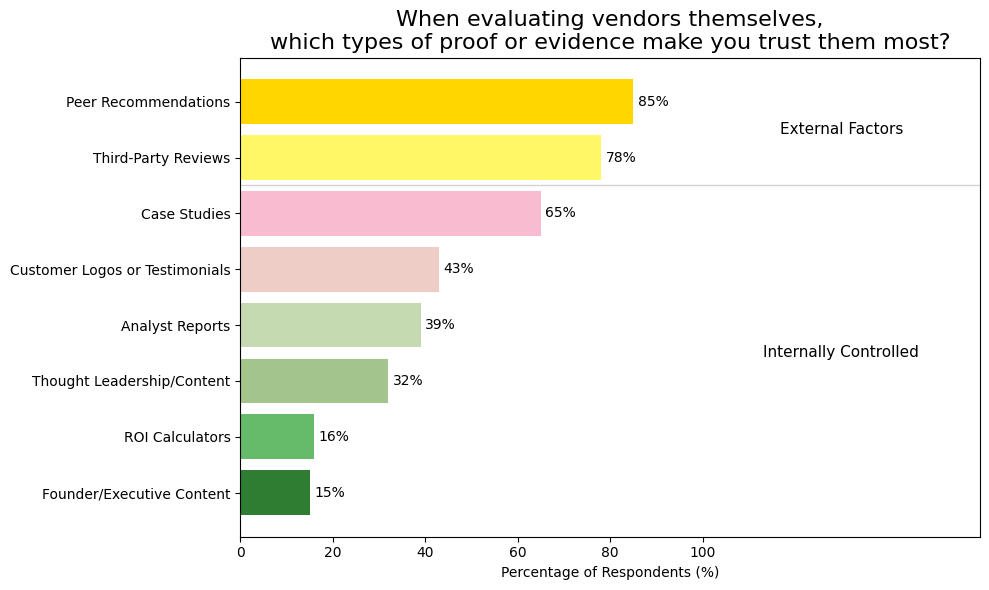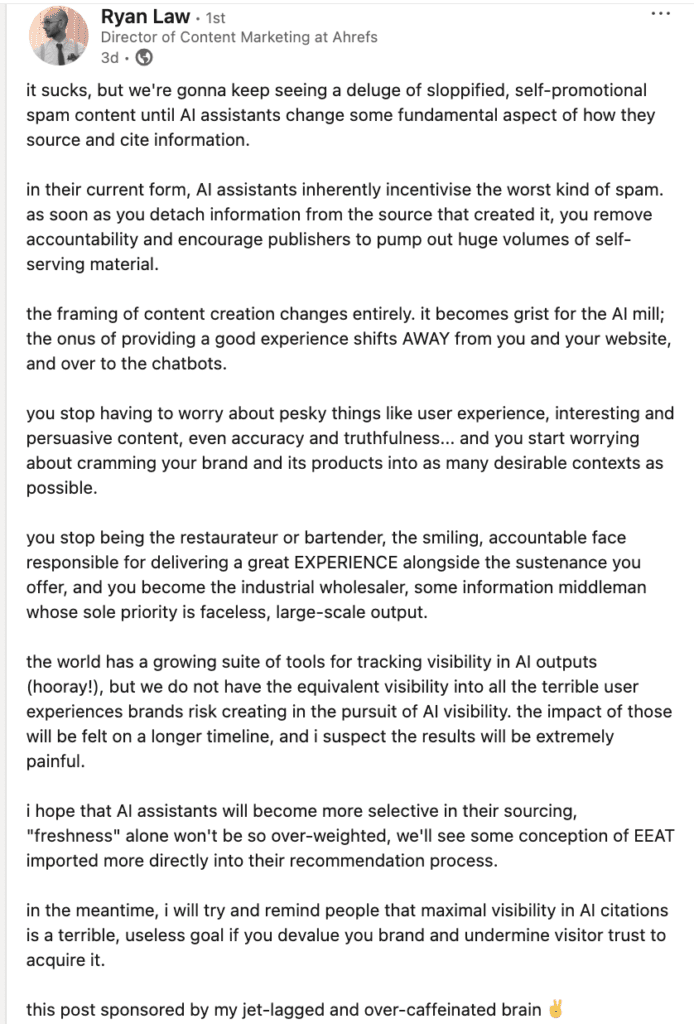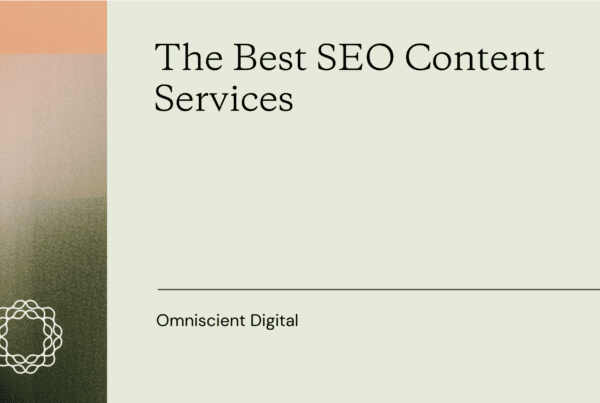
I had double dinner with a friend and fellow agency owner the other night.
Meaning, for the curious, that during the 30 minute wait for our table at Emily, we decided to pre-game with a slice of pizza.
Gluttonous? Yes. But it gave us plenty of time and caloric energy to discuss the state of AI search and how we’re approaching it.
We converged on this idea that we may be applying old paradigms to a new model.
It’s indeed interesting and useful, directionally at least, to see where our brands and clients stand in AI visibility.
More important, however, is how they are being described and, even upstream of that, how the problems, narratives, and topics are being described and/or influenced by our brands and clients.
This stuff is not easy to track.
Numerators, Demoninators, and Myopia
In LLMs, influence is often upstream of measurable behavior.
There are pretty strong claims being made on both sides of the spectrum – those who think GEO is a nothingburger, and those who think it’s displacing all other forms of product and information discovery.
On one side, you’ll see a claim that sounds like this: “AI engines represent only 1% of a website’s traffic, whereas Google search still represents 50% of website traffic.”
I’m making up the numbers there, but you’ve seen the statistics.
This is obviously underestimating the influence of LLMs, as most people do not click on links and trigger referral traffic to a website.
On the other side, you’ll see a claim that sounds like this: “Traffic from LLMs converts at 5X the rate of other traffic sources.”
This is more interesting, but it suffers from the same logic gap: most of the exposure generated from LLMs does not get tracked as traffic. The small percentage that clicks through, many to a homepage or pricing page (indicating prompts that are very high intent, product aware, and in-market), are logically higher intent.
Conversion rates are formulas with a numerator as well as a denominator. In this equation, we’re forgetting about the denominator – the 100,000 people who saw your brand in ChatGPT but didn’t click (or they Googled your brand name after and went directly to your site, thus borking your attribution models).
Again, in LLMs, as well as many other marketing channels, influence is upstream of measurable behavior.
We conducted research recently on 100 business decision makers and found that a significant portion of them started their customer journey with an LLM (42%). However, according to our research, 37% of buyers stop using LLMs after early research — but that early exposure shapes which vendors even enter the consideration set. Influence happens in the shadows of visibility.
What happens, in reality, is decision makers ping pong from LLMs and Google to peer conversations, review sites, and even branded materials to fact check what they are finding in LLMs.

We haven’t even introduced the idea of memory and personalization as it related to LLMs, which throws another curve ball into traditional organic metrics like rankings, impressions, clicks, and traffic.
What’s the Value of a Narrative?
“A culture’s ability to understand the world and itself is critical to its survival. But today we are led into the arena of public debate by seers whose main gift is their ability to compel people to continue to watch them.”
― George Saunders, The Braindead Megaphone
I don’t like posting on LinkedIn, but I often feel I am handcuffed by a subtle prisoner’s dilemma.
You see, people I want to work with are on LinkedIn. They are reading posts from people who post on the platform, some of whom offer sensationalist takes, some of whom offer good advice, and some of whom are completely full of shit (this is the professional term).
If I am not active on the platform at all, I risk ceding control of the narrative, entirely, to only the people who are willing to spend the time, energy, and money to post on LinkedIn.
The past few years, this environment has been more noisy and volatile than ever, with constant claims of SEO’s demise, the mythical organization that runs on three employees and a daisy chain of autonomous agents pumping millions of pipeline through some opaque process, and a whole lot of inaccurate claims of how LLMs work or don’t work.
I’m not saying I’m a beacon of perfect information, but I do aspire to be a rational voice amidst a sea of cacophonous chatter.
Narrative matters. Macro factors and the zeitgeist, so to speak, impact our metrics more than we’d like to think (as I learned after A16Z’s GEO article was published, with a flood of leads coming in the following weeks and months).
So I think it warrants serious thought on how the narrative in search and LLMs is architected, which goes above and beyond brand mentions and brand visibility.
We lament falling click-through-rates slain by the robotic hands of AI overviews – and I do think there’s a whole lot of negative externalities that are resulting from this traffic theft – and we don’t have a great way to measure our brand’s impact of effect on the outputs of these AI generated responses.
Is there any value in being the source from which an AI Overview, ChatGPT, or Perplexity query pulls?
If we ever believed there were value in ranking and attracting traffic for pages like “the ultimate guide to content marketing” or “what is a term sheet,” then we have to believe that there is value in being the (mostly invisible) voice behind the AI Overviews as well, if only to put our point of view into the ether.
This is probably truer in spaces where consensus has not been developed, for instance in emerging categories or with owned or branded phrases.
I don’t think, for example, it matters a ton whether Sprout, Hootsuite, or HubSpot is the source behind the snippet “what is social media marketing?”
I do, however, think it’s beneficial for Gable to be the source behind something like “what does it mean to shift left in the context of data quality and management?”
Citation Rates, Brand Mentions, and AI Visibility
It’s possibly important to track your brand’s rate or proportion of citations within a set of prompts as an approximation of your power or influence over the outputs.
I don’t think this is a performance metric or anywhere near it.
It may not even be a leading indicator of a lagging performance metric.
But it’s probably a good indication, if you’ve properly chosen the prompts you are tracking, that your owned content is effectively answering questions your audience cares about and impacting the narrative they are consuming.
This is something we look at, though don’t report on as a primary metric, especially with clients whose strategy is heavily indexed on owned content creation and website pages.
As long as we have chosen our prompts fairly, it is generally a good sign if the proportion of source citations is increasing for our client’s domain.
Competitors, Comparisons, and More Game Theory
We’re often advising companies, especially challenger brands, to create content that mentions (gasp) their competitors.
Comparisons, categorical overviews, etc.
It’s been abundantly clear for many years that these types of pages work well in traditional search, often generating a conversion rate as high as seen on product or commercial pages. This insight was the seed of the Surround Sound SEO strategy, which is now the emerging default “playbook” for GEO (brand mentions are the new backlinks, they say).
So listicles are not new, nor are they a “GEO tactic.”
Still, brands are reticent. They don’t want to shed light on competitors, lest they make them more salient than they would otherwise have been.
The thing with LLMs is you’ve got this game theory where, if you don’t architect your brand and product narrative within a category or a competitive set, someone else (G2, your competitors, or Reddit) will do it for you.
I’m not saying you need to spam the LLM machine with hundreds of slop listicles (don’t do that). But on the flip side, we’ve worked with enterprise brands who have such sparse information on their site that the LLMs are not functionally able to speak to their advantages, features, or who the product is best for.
If you don’t publish accurate information about your product, industry, and competitive landscape, who will? Someone will.
Widen Your Aperture
Influence in LLMs is somewhat controllable in the sense that you can and should publish content that answers buyer questions and speaks accurately about problems your product solves.
But much of the influential sources come not from your megaphone from the reverberating echoes of the broader web, including some particularly cantankerous sources like anonymous Redditors.
So SEOs need to widen their aperture beyond on-page, technical, and even beyond link building.
Optimizing for LLMs, wherever the tactics will land, will require a broader purview, a more inclusive and cross-functional approach, and probably an owner who is not, archetypically, an SEO.
For now, I see it best as either a dedicated function or sitting underneath a cross-functional marketing leader (depending on your org structure, a director or VP who pulls the strings of affiliate, customer marketing, paid acquisition, and probably has a weekly coffee meeting with the brand director).
As an SEO, this is your opportunity to move from the proverbial nerds table to a table with nicer silverware and better wine.
You’ll need to learn to speak a new language and play nicely with teams who may not understand what you do. But if you can translate what you’ve been doing – owned content creation, on-page SEO and structured content, link building and off-page, technical SEO and website performance – into the language of AI discovery, then you’re likely to be rewarded with a broader scope, more resources, and a more attentive executive audience when presenting in team meetings.
Some of this is independent of LLMs (again, see the research on actual B2B decision makers and how they leverage LLMs in their purchase journey).
Peer recommendations, third party reviews, and case studies dominate when it comes to proof, evidence, and ultimate decision making, all of which extend beyond keywords and content.

Does Credibility Mean a Thing?
“Credibility has become a commodity not only to be feigned but also to be bought and sold on the open market.” – Anthony R. Pratkanis, Age of Propaganda
If you read enough history books, particularly the history of advertising and public relations, you’ll realize that information, particularly about products and brands, has never truly been neutral or objective. For better or for worse, there are usually puppeteers trying to architect narratives and sway public opinion in their favor.
The modern problem is that LLMs tend to abstract away source data that some readers (even if a small percentage) would use to verify claims and weigh the credibility of them.
Ryan Law put it well in a recent LinkedIn post:

And in the data, we see that B2B buyers are still skeptical and will almost always fact check and verify claims they read through LLMs. As one respondent put it:
“There isn’t anything that an LLM’s answer could include that would have me add it to the shortlist with little or no manual checking. I simply don’t trust LLMs to have accurate information all the time and don’t want to risk my reputation on the answer given by an LLM.”
– Director of Marketing, 201-500 employees, SaaS/Software
For what it’s worth, this was a problem with Google search as well, where users began to distrust SEO-ified content and began to append the word “reddit” to their searches.
The agentic future may come to pass, but currently, at least for large business purchases that incur professional risk, we’re still at the “trust but verify” stage of the technology.
Surround Sound SEO & Brand Gravity
“Often we don’t realize that our attitude toward something has been influenced by the number of times we have been exposed to it in the past.”
― Robert B. Cialdini, Influence: The Psychology of Persuasion
Influence is often a result of consensus (again, for better or for worse).
If your brand is ubiquitous – not only mentioned in LLM citations and search rankings, but also favorably reviewed on Reddit and by peer groups – you have a very good chance of being chosen, and an even better chance of entering the consideration set.
So, practically, this is a strategic objective we work on with our clients: building brand gravity.
Some of this looks like bread and butter SEO. Some of this looks like digital PR and Surround Sound SEO. Some of it is experimental (creating a print magazine, running Reddit campaigns, building YouTube channels, etc.).
Ultimately, many pieces have to be in place, aligned and coordinated, to create a cohesive presence across customer journey touchpoints. LLMs are doing their part in summarizing, truncating, and collating this into a single answer, which is informing much more of the customer journey now (and will continue to grow in influence in the future).
Hey, it’s more interesting that publishing another “Ultimate Guide to [Keyword]” – right?
Want more insights like this? Subscribe to Field Notes


